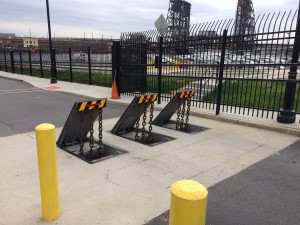The 45-Second Trick For Wedge Barriers
Wiki Article
Wedge Barriers Fundamentals Explained
Table of ContentsWedge Barriers Fundamentals ExplainedExcitement About Wedge Barriers

Some Known Details About Wedge Barriers
g., springtime support 65 )may be taken care of to completion of the spring pole 58 to make it possible for compression of the springs 60. As the springtimes 60 are pressed in between the springtime supports 62, the springtime setting up 54 generates a force acting on the camera combined to the spring pole 58 in an instructions 66. The remaining force applied to the cam to deploy release wedge plate 16 may might provided given an electromechanical actuator 84 or other various other. Because of this, the spring assembly 54 and the actuator 84(e. g., electromechanical actuator)may operate with each other to convert the web cam and raise the wedge plate 16.
As mentioned over, the spring assembly 54 puts in a constant pressure on the cam, while the electromechanical actuator might be regulated to apply a variable force on the webcam, therefore allowing the lifting and reducing( i. e., releasing and pulling back )of the wedge plate 16. In specific personifications, the constant pressure applied by the spring assembly 54 may be flexible. g., electromechanical actuator) is impaired. As will be appreciated, the springtime assembly 54 may be covered and secured from particles or various other aspects by a cover plate(e. g., cover plate 68 displayed in FIG. 4) that might be substantially flush with the raised surface area 38 of the structure 14. As mentioned over, in the deployed position, the wedge plate 16 offers to obstruct gain access to or traveling past the barrier 10. The barrier 10(e. g., the wedge plate 16 )might obstruct pedestrians site here or lorries from accessing a building or path. As discussed over, the barrier 10 is attached to the support 30 secured within the foundation 14,

front brackets 71. Because of this, the affiliation assemblies 72 may pivot and rotate to make it possible for the collapse and extension of the link settings up 72 throughout retraction and deployment of the bather 10. The linkage assemblies 72 cause activity of the wedge plate 16 to discover this be restricted. As an example, if an automobile is taking a trip towards the released wedge plate 16(e. For example, in one scenario, the safety legs 86 might be prolonged duringmaintenance of the obstacle 10. When the safety and security legs 86 are deployed, the security legs 86 sustain the weight of the wedge plate 16 versus the surface 12. Consequently, the training mechanism 50 might be shut off, serviced, removed, changed, etc. FIG. 5 is partial perspective view of an embodiment of the surface-mounted wedge-style barrier 10, showing the webcam 80 and the cam surface areas 82 of the training device 50. Especially, 2 webcam surface areas 82, which are referred to as reduced webcam surface areas 83, are placed listed below the webcam 80. The lower web cam surface areas 83 might be taken care of to the surface 12 (e. For instance, the reduced webcam surfaces 83 and the mounting plate 85 might create a single piece that is safeguarded to the anchor 30 by screws or other mechanical bolts. Furthermore, two camera surfaces 82, which are described as upper camera surfaces 87, are placed over the camera 80 and paired to (e. In other personifications, stepping in layers or plates may be positioned in between the surface 12 and the reduced webcam surface areas 83 and/or the wedge plate 16 and the top cam surface areas 87 basics As discussed over, the webcam 80 converts along the cam surface areas 82 when the wedge plate 16 is raised from the pulled back placement to the released setting. In addition, as mentioned over, the springtime assembly 54 (see FIG. 3 )may supply a force acting upon the cam 80 in the instructions 102 via spring rod 58, which may reduce the pressure the electromechanical actuator 84 is called for to relate to the cam 80 in order to actuate and raise the wedge plate 16. 1 )to the deployed placement(see FIG. 4). As shown, the webcam 80 consists of track wheels 104(e. g., rollers), which contact and translate along the cam surfaces 82 during procedure.
Report this wiki page